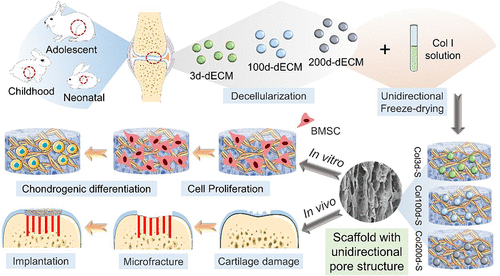当前位置:
X-MOL 学术
›
ACS Appl. Mater. Interfaces
›
论文详情
Our official English website, www.x-mol.net, welcomes your
feedback! (Note: you will need to create a separate account there.)
Childhood Cartilage ECM Enhances the Chondrogenesis of Endogenous Cells and Subchondral Bone Repair of the Unidirectional Collagen–dECM Scaffolds in Combination with Microfracture
ACS Applied Materials & Interfaces ( IF 8.3 ) Pub Date : 2021-11-22 , DOI: 10.1021/acsami.1c19447 Hongfu Cao 1, 2 , Xiuyu Wang 3 , Manyu Chen 1, 2 , Yuhan Liu 3 , Xiaolin Cui 4, 5 , Jie Liang 1, 2 , Qiguang Wang 1, 2 , Yujiang Fan 1, 2 , Xingdong Zhang 1, 2
ACS Applied Materials & Interfaces ( IF 8.3 ) Pub Date : 2021-11-22 , DOI: 10.1021/acsami.1c19447 Hongfu Cao 1, 2 , Xiuyu Wang 3 , Manyu Chen 1, 2 , Yuhan Liu 3 , Xiaolin Cui 4, 5 , Jie Liang 1, 2 , Qiguang Wang 1, 2 , Yujiang Fan 1, 2 , Xingdong Zhang 1, 2
Affiliation

|
Despite the formation of mechanically inferior fibrocartilage, microfracture (MF) still remains the gold standard to repair the articular cartilage defects in clinical settings. To date, although many tissue-engineering scaffolds have been developed to enhance the MF outcome, the clinical outcomes remain inconsistent. Decellularized extracellular matrix (dECM) is among the most promising scaffold for cartilage repair due to its inheritance of the natural cartilage components. However, the impact of dECM from different developmental stages on cellular chondrogenesis and therapeutic effect remains elusive, as the development of native cartilage involves the distinct temporal dependency of the ECM components and various growth factors. Herein, we hypothesized that the immature cartilage dECM at various developmental stages was inherently different, and would consequently impact the chondrogenic potential BMSCs. In this study, we fabricated three different unidirectional collagen–dECM scaffolds sourced from neonatal, childhood, and adolescent rabbit cartilage tissues, and identified the age-dependent biological variations, including DNA, cartilage-specific proteins, and growth factors; along with the mechanical and degradation differences. Consequently, the different local cellular microenvironments provided by these scaffolds led to the distinctive cell morphology, circularity, proliferation, chondrogenic genes expression, and chondrogenesis of BMSCs in vitro, and the different gross morphology, cartilage-specific protein production, and subchondral bone repair when in combination with microfracture in vivo. Together, this work highlights the immature cartilage dECM at different developmental stages that would result in the diversified effects to BMSCs, and childhood cartilage would be considered the optimal dECM source for the further development of dECM-based tissue engineering scaffolds in articular cartilage repair.
中文翻译:

儿童软骨 ECM 结合微骨折增强内源性细胞的软骨形成和单向胶原-dECM 支架的软骨下骨修复
尽管形成了机械性劣质纤维软骨,但微骨折 (MF) 仍然是临床环境中修复关节软骨缺损的金标准。迄今为止,尽管已经开发了许多组织工程支架来增强 MF 结果,但临床结果仍然不一致。脱细胞细胞外基质 (dECM) 是最有前途的软骨修复支架之一,因为它继承了天然软骨成分。然而,不同发育阶段的 dECM 对细胞软骨形成和治疗效果的影响仍然难以捉摸,因为天然软骨的发育涉及 ECM 成分和各种生长因子的明显时间依赖性。在这里,我们假设在不同发育阶段的未成熟软骨 dECM 本质上是不同的,因此会影响软骨形成的潜在 BMSC。在这项研究中,我们从新生儿、儿童和青春期兔软骨组织中制造了三种不同的单向胶原蛋白-dECM 支架,并确定了与年龄相关的生物学变异,包括 DNA、软骨特异性蛋白和生长因子;以及机械和退化的差异。因此,这些支架提供的不同局部细胞微环境导致 BMSCs 在体外具有独特的细胞形态、圆形度、增殖、软骨基因表达和软骨形成,以及不同的大体形态、软骨特异性蛋白产生和软骨下骨修复。与体内微骨折相结合。一起,
更新日期:2021-12-08
中文翻译:

儿童软骨 ECM 结合微骨折增强内源性细胞的软骨形成和单向胶原-dECM 支架的软骨下骨修复
尽管形成了机械性劣质纤维软骨,但微骨折 (MF) 仍然是临床环境中修复关节软骨缺损的金标准。迄今为止,尽管已经开发了许多组织工程支架来增强 MF 结果,但临床结果仍然不一致。脱细胞细胞外基质 (dECM) 是最有前途的软骨修复支架之一,因为它继承了天然软骨成分。然而,不同发育阶段的 dECM 对细胞软骨形成和治疗效果的影响仍然难以捉摸,因为天然软骨的发育涉及 ECM 成分和各种生长因子的明显时间依赖性。在这里,我们假设在不同发育阶段的未成熟软骨 dECM 本质上是不同的,因此会影响软骨形成的潜在 BMSC。在这项研究中,我们从新生儿、儿童和青春期兔软骨组织中制造了三种不同的单向胶原蛋白-dECM 支架,并确定了与年龄相关的生物学变异,包括 DNA、软骨特异性蛋白和生长因子;以及机械和退化的差异。因此,这些支架提供的不同局部细胞微环境导致 BMSCs 在体外具有独特的细胞形态、圆形度、增殖、软骨基因表达和软骨形成,以及不同的大体形态、软骨特异性蛋白产生和软骨下骨修复。与体内微骨折相结合。一起,


















































 京公网安备 11010802027423号
京公网安备 11010802027423号